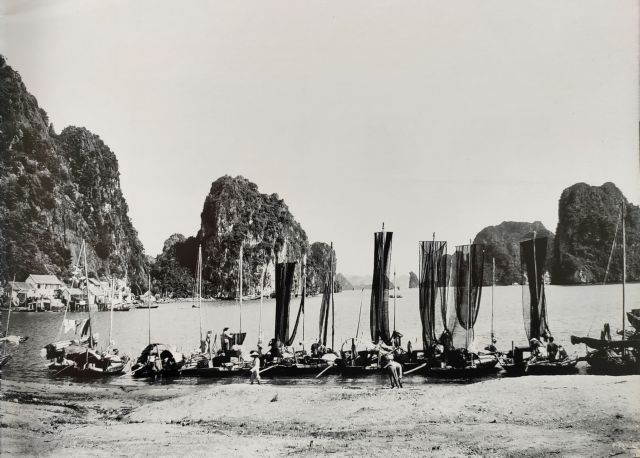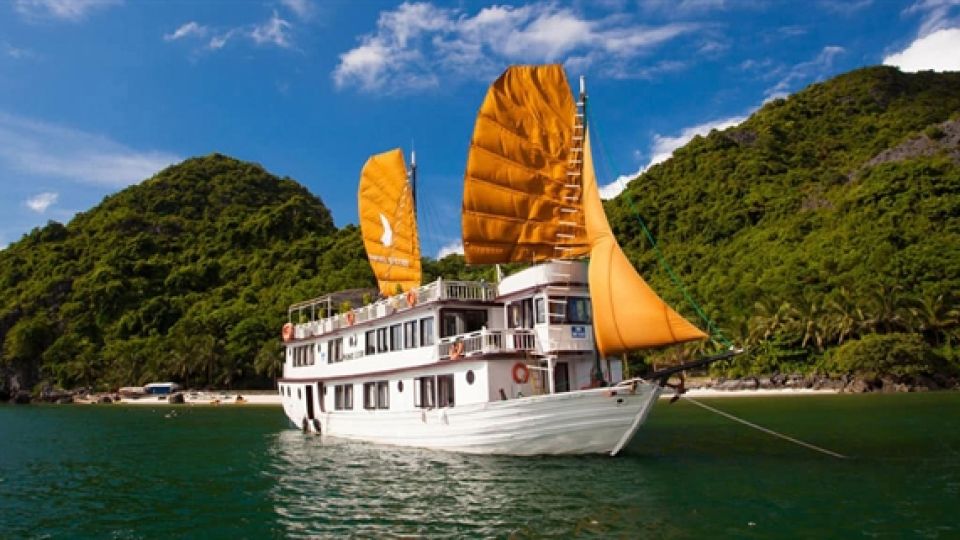February 28, 2022
HANOI – Thirty years after the first documented application for Hạ Long Bay to become a UNESCO Natural Heritage site, work on this natural gem of Việt Nam still seems unfinished.
The administrative institution that oversees Hạ Long Bay and its neighbouring natural landscapes of Lan Hạ Bay and the Cát Bà Archipelago, has a lengthy catalogue of preservation work that has been carried out to date: a master plan for Hạ Long Bay, World Natural Heritage plans until 2030, tourism solutions for Hạ Long Bay, Hạ Long Bay Natural Preservation area, Hạ Long Bay Tourism Zone, a Foundation for Hạ Long Bay Natural Heritage. The list goes on.
But the top priority project was always to coordinate with Hải Phòng City authorities to apply to the UN culture agency UNESCO for Hạ Long Bay – Cát Bà Archipelago to have the World Natural Heritage title. This was all part of an attempt to enlarge the surrounding borderline of the site to not only embrace the previous heritage but also add different dimensions to make the new proposal a larger preservation area with a global approach.
Hạ Long Bay has been bestowed with a UNESCO title for nearly 30 years; during the long course, it also faced warnings of title withdrawal for failing to maintain the environment.
If you are visiting Hạ Long City today, you will be amazed by the new city plans, the tree-lined seaside boulevards, and the beautiful limestone-karst mountains standing in the sea in numerous shapes.
Hạ Long was once close to Việt Nam’s most prominent open-pit coal mines. The coal dust used to cover the city with trucks unloading coal.

TRANQUILITY: An ink-painting like landscape at the foot of Bài Thơ Mountain
Quảng Ninh Province and Hạ Long City authorities have been steadily steering the city toward modern urbanisation with natural preservation.
Thirty years on, anyone who visits can easily see the positive gains. But, of course, there have been losses that will never be brought back.
Fishing village turned tourist hub
There was an unlikely man who was at the forefront of the area getting its much-vaunted UNESCO status.
In the application to the UN culture agency back in 1991, a series of stunning black and white images were taken of the region by a little known amateur photographer. Looking at the photos today and you are sucked into another world, another era, and it is clear that while Hạ Long has developed, something has been lost.
Writer-turned-photographer Đỗ Kha now lives in a comfortable home overlooking the main street of Hạ Long City. Turning the pages of his coffee-table books, he talks about his journey to capture the beauty of his native town and bay, which is now gone for good.
“I used 15 rolls of film and had a week to present a visual collection to the UNESCO Committee,” Đỗ Kha, 84, says. “It was an [economic] hard time; I got seven rolls provided by the Quảng Ninh Province office and bought eight more. I had a week to take all the photos and finally came up with 160 pictures.”
The photos played an essential role in the documentation of the area, and in 1994, UNESCO recognised Hạ Long Bay as a World Natural Heritage site.

BAY OF BOATS: The floating fishing village of Lán Bè.Photos Đỗ Kha
The Literature and Arts Weekly even commented on the process: “For Đỗ Kha, the biggest test was the file on Hạ Long submitted to UNESCO, which included his 160 slides of the bay. Đỗ Kha contributed his small share to the process of finalising the file to make the world officially recognise the unequal beauty of his homeland.”
Đỗ Kha’s first job was in mining. He worked in the mines for eight years from 1955, and then, he started to pen some articles and learn to paint. His stories were printed in the Quảng Ninh newspaper.
“I started writing articles, then short stories and even composed some poems, and was assigned to work at the literary desk,” he says.
“But I also loved photography, so I would go to the wharf during my free time and try to get on the boats to travel the bay and take some photos.”
Back then, few people took the time, had the expenses, or even an interest in accumulating black and white photos of the bay. But something about the beauty of the mystic limestone karsts pulled Đỗ Kha in.
“I did not have a camera of my own. I had to borrow an East Germany camera from our office, and returned it after each trip,” he says. “The film selection was also limited to those from East Germany, the Soviet Union and Czechoslovakia.”
“Every time I could borrow a camera, I would try my best to climb a mountain or take a boat out to the bay to take photos.”
He recalls taking part in a photography camp and being the only one who did not own a camera.
“Come to my house; I’ll lend you a camera,” a fellow student told him.
For the final project, Đỗ Kha biked 60km from Hạ Long to Đông Triều to borrow a fixed lens camera, which was the only option available at the time.
The black and white photos of the fishing boats on the bay, the mountains, and the fishing villages with Hạ Long’s signature brown sails and fishing nets show the authentic life of a long-disappeared world.
“Before Việt Nam opened its doors in the 1980s, fishermen used to have fishing nets weaved from jute strings. The nets had to be washed and dried every time after fishing. They looked very graceful. The boats looked aged, antique and weather-beaten,” he says.
“But since the doors were opened, plastic fishing nets became available, and the jute nets gradually replaced. And the boats added electrical engines.”
Then the sails were slowly gone, too.
It was an inevitable drive toward a faster, more modern world, and there is no turning back.

BYGONE ERA: Drying fishing nets for the next day’s trip
But life has always changed here. The ancient floating villages of Vung Viêng and Lán Bè were moved ashore over a decade ago. Families were given land slots to build houses; children went to school. Their floating life on board was over, ending an uncertain way of life, which lacked sanitary standards, healthcare, and schooling for children.
The fishing villages in the area today have been kept for tourists alone.
Urbanisation
In the last month of 2021, the Prime Minister approved an urban master plan for Hạ Long City until 2040, for the city to become a logistics centre of the country.
The planned size will be more than 112,130ha. A population of 328,000 will expand to around 620,000 by 2030, and reach over 800,000 by 2040
According to the plan, the objective of the urban development is to make Hạ Long City move toward sustainable, green growth and adapt to climate change. The plan takes Cửa Lục wharf as the connecting centre, which will be developed into a multi-centre network and harmonise with the Hạ Long Bay World Natural Heritage site and the northern mountain ranges.
The plan aims to take the most advantage of Hạ Long’s potential and location, create more jobs, increase urban living standards, and expand transport to accommodate tourism growth. An emphasis on public transport, marine wharf services, and logistics centres will gradually make Hạ Long the country’s logistics centre.
The master plan says it aims for growth to be in harmony with preservation requirements for the Hạ Long World Natural Heritage site and the natural preservation of Đồng Sơn-Kỳ Thương park.
Some 12 months since the project was approved, planning is in full swing. The process shall take into account a new development to connect the new Hạ Long urban centre with neighbouring cities and towns, with further development in the east and west of Cửa Lục Bay, and new centres in the north of the bay with tourism services, clean industrial zones and high-tech parks.
Another master plan to develop the northern area of Hạ Long City by 2040 was approved by the province’s People’s Committee in 2019, according to which three architectural landscaping were outlined: an urban eco-town, an agricultural corridor embracing the valley along National Road 279 and the northern hilly area in Đồng Sơn and Kỳ Thương communes.
The overall development direction is to preserve traditional values, maintain traditional crafts, use location specifications to create new trends, and keep the new administrative and functional buildings connected to aid the local economy.
Each centre’s technical infrastructure will be balanced with environmental treatment for each zone. Other facilities include public transport, reservoirs, urban lighting, and a wastewater drainage system. It aims to be eco-friendly and energy saving, using innovative technology.
Vũ Trường Thành, deputy chief of Hạ Long Urban Management Office, announced that the city had completed a detailed plan for five new urban centres, using the state budget for Hạ Long City on significant and strategic construction. They are also mobilising funding from the private sector and other social sources to support the plan.
A new Hạ Long City shall have four main urban areas: Cửa Lục Bay at the centre, eco-towns with supporting services in the north, the administrative, commercial and cultural centre in the east, and a tourist town, services, industrialisation and seaport in the west.
In the first phase from 2019 to 2020, the city completed the urban architectural planning and proposed to develop a new green and intelligent urban centre.
The next phase from 2021 to 2030 will focus on developing and increasing seaside space quality. Seashore roads, public spaces and services by the sea will be completed.
The years from 2031 to 2040 will increase the network to connect with Quảng Yên and Cẩm Phả to make a larger space in harmony with the core principles: preserving and boosting the values of Hạ Long Bay.
Hạ Long of the future
Hạ Long Bay’s beauty comes from three elements: limestone karsts, the water and the sky.
The bay boasts nearly 2,000 islands with the unravelled natural beauty of mountains standing in the water and numerous limestone karst caves.
The natural beauty of Hạ Long may still be there, but many local traces have been lost in the course of development. The floating fishing villages will be maintained to host tourists, but the wooden boats with traditional brown-red sails will be replaced by all-white boats, with more of a tourist touch.
If you plan to visit Hạ Long Bay and see it as a World Natural Heritage site in all its glory, you may need to go soon. Go while you still can. The tourist sites are open.
Even when all the fishing villages and boats are nothing but a mere memory, the bay will always be beautiful. VNS


